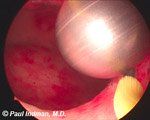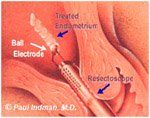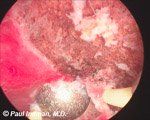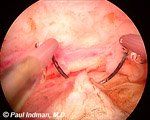Difficult Decision for 46 year old Woman with Heavy Bleeding from Submucous Fibroid
March 9, 2010 a 46 year old woman came to me having been told that she needs a hysterectomy because of heavy bleeding from her fibroid. She wanted to know her options. Ultrasound showed a tennis ball size fibroid that was 2/3 in the uterine wall and 1/3 in the cavity of the uterus.
March 9, 2010 a 46 year old woman came to me having been told that she needs a hysterectomy because of heavy bleeding from her fibroid. She wanted to know her options. Ultrasound showed a tennis ball size fibroid that was 2/3 in the uterine wall and 1/3 in the cavity of the uterus. We confirmed the ultrasound by doing an office hysteroscopy, where we could see the fibroid protruding into the cavity.Read on to learn about her options and see photographs of her treatment.

Option 1: Medicines
Although birth control pills may decrease bleeding with periods, this woman had a blood clotting disorder preventing her to take them. While some medicines can temporarily shrink fibroids, there are none that have been effective and shown to be safe for long term use. Since the average age of menopause is 51, she would likely need to take them for 5 years.
Option 2: Progesterone IUD (Mirena)
The progesterone IUD will often decrease bleeding, but the fibroid would have interfered with placement and likely cause it to be expelled
Option 3: Fibroid embolization (UAE or UFE)
Frequently will decrease bleeding. Often when a submucous fibroid is embolized women have a long term heavy discharge as the dead fibroid is shed. Some experts do not think embolization is a good choice for submucous fibroids.
Option 4: Endometrial ablation

Endometrial ablation is a procedure in which the lining of the uterus is removed or destroyed. It does not require hospitalization, and most women return to normal activities in a day or two. After a successful endometrial ablation, most women will have little or no menstrual bleeding.
It is often possible to remove the fibroid at the same time using the same instruments. Even if the entire fibroid is not removed many women will be cured of their heavy bleeding. One risk is that with time any remaining fibroids will grow, requiring further treatment. In addition, doing endometrial ablation in a uterus with submucous fibroids takes utmost skill and judgement.
Option 5: Abdominal, laparoscopic, or robotic myomectomy.
Taking out the fibroid will most likely restore the uterus to normal function. All of these require one or more incisions into the abdomen.
Option 6: Hysterectomy
Taking out the uterus is the most invasive of all of her choices, but is the only one with a guarantee that her bleeding problems will be permanently solved. While a women her age would definitely want to keep her ovaries, there are many variations on hysterectomy (laparoscopic, robotic, abdominal, vaginal, supracerical, etc.). Should she choose any of the more conservative options she always has the option of hysterectomy should they fail.
HER CHOICE: Hysteroscopic myomectomy with endometrial ablation at the same time
Here are photographs of her actual procedure, done April 7, 2010.
The first photo is the view through the resectoscope, as illustrated above. The fibroid protrudes into the back of the uterus.
Before removing the fibroid, as much of the endometrium(uterine lining) is destroyed with the ball. Treated endometrium is on the right.

A loop is then used to shave off as much of the fibroid as possible. (See hysteroscopic myomectomy.)

Here is the pieces of fibroid that were removed.
Four Month Follow-up
I saw her August 10, 2010. Her periods have gone from being so heavy that they interfered with to normal activities to where she only needs 1 to 2 panty liners a day. She is extremely happy with the results.
Comment: There was no right or wrong choice. Women with submucous fibroids rarely have long-term success with medicines, so postponing treatment would have just meant more bleeding. Since most women can go back to most normal activity several days after hysteroscopic treatment, she felt that this was the least intrusive treatment. Most likely it will last until menopause, but hysterectomy is the only treatment with a guarantee. - Paul Indman, M.D.
Editor's Note: This post was picked up from Uterine Fibroids blog: An Expert Speaks Out.The blog posts do not intend to diagnose, treat, or cure any condition and are not a substitute for consultation with a physician. The postings are presented for educational purposes only.
Recap on reproductive rights with David Hackney, MD, MS
December 20th 2022In this episode of Pap Talk, we spoke with David Hackney, MD, MS, maternal-fetal medicine physician at Case Western Reserve University and chair of ACOG's Ohio chapter for a full recap of where restrictions on reproductive rights have been and where they're going.
Listen
In this episode of Pap Talk, Gloria Bachmann, MD, MSc, breaks down what it means to be a health care provider for incarcerated individuals, and explores the specific challenges women and their providers face during and after incarceration. Joined by sexual health expert Michael Krychman, MD, Bachmann also discusses trauma-informed care and how providers can get informed.
Listen
No link found between hormonal contraception and clitoral adhesion severity
February 28th 2025A recent study presented at the ISSWSH 2025 Annual Meeting found no significant association between hormonal contraceptive use and the severity of clitoral adhesions, though researchers emphasize the need for further investigation.
Read More
